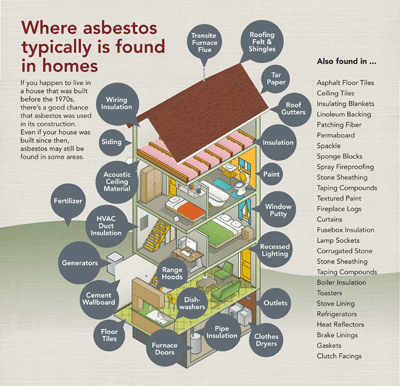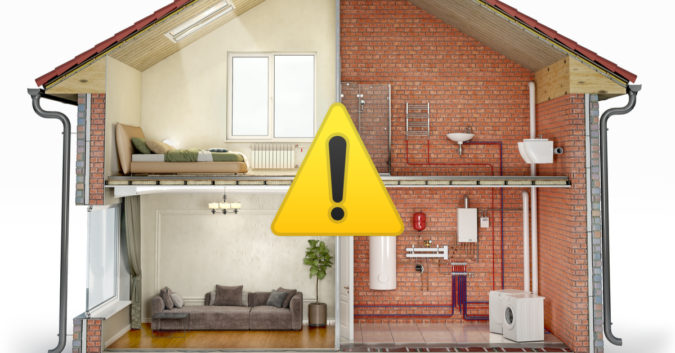February 2021 marks National Cancer Prevention Month, a month-long awareness campaign sponsored by the Prevent Cancer Foundation. Each year, cancer kills over 600,000 Americans. In the United States — and globally — it is the second-leading cause of death.
This month, Sokolove Law is supporting National Cancer Prevention Month by bringing awareness to certain cancer prevention measures that impact ordinary Americans — within their communities, at their jobs, and even inside of their own homes.
In our second National Cancer Prevention Month blog post, we will take a closer look at the cancer hazard of asbestos in homes: how asbestos got inside of buildings and houses in the first place, where asbestos may be lurking inside, and what you should do if you find asbestos.
Asbestos in the Home
According to the research and advocacy organization, the Environmental Working Group (EWG), between 12,000 to 15,000 Americans die each year from asbestos-related diseases. Mesothelioma, the lethal cancer caused exclusively by asbestos, kills around 3,000 Americans every single year.
Despite what many commonly believe, asbestos is not a man-made material — it is a naturally occurring mineral that was used for much of the 20th century by companies that manufactured asbestos-containing products.
While the companies that made these products knew about the health risks associated with asbestos, they made the calculated decision not to warn the public or their own workers, exposing generations of Americans to the deadly carcinogen.
Due to its natural ability to withstand heat, fire, and electricity, and its strength and durability, asbestos seemed to many companies like a “miracle mineral.” To these companies, asbestos was cheap and abundant, and, if used in the manufacturing of certain types of products, could drive immense profits.
That’s how asbestos found its way into many common household building materials and products in the 20th century, and why it continues to be a deadly problem today.
Where Is Asbestos in the Home?
Right now, asbestos is present in roughly 30 million homes in the United States alone. The older a house is, the more likely it was built with asbestos-containing materials.
In constructing American buildings, facilities, and houses, companies utilized asbestos-containing materials in insulation, fireproofing, roofing, pipe wrap, electric wiring, and dozens of other applications.
Given the widespread use of asbestos in the 20th century, construction materials have left behind a hidden danger that lurks inside of many houses — in the floors, baseboards, ceilings, and walls.
The image below shows some of the locations within a typical 20th-century house where asbestos-containing materials were used.

Asbestos may also be found in:
- Attic and floor insulation
- Boilers and water heaters
- Ceiling texture
- Electrical panels
- Furnaces
- Pipes
- Roofing shingles
- Vinyl flooring
Remember: asbestos is a cancer-causing substance. If you know of or discover asbestos-containing materials in your home, be careful: Do not touch or disturb these materials.
Asbestos is at its most dangerous when it is in “friable” form, meaning it can be easily broken apart. When asbestos is disturbed, microscopic asbestos fibers can become airborne — presenting a serious health hazard.
What to Do If You Find Asbestos In Your Home
If you locate asbestos-containing materials within your home, the very first thing you should do is leave the materials in-place and keep people from disturbing the area, which could inadvertently release asbestos fibers into the air.
Next, you will want to contact a certified asbestos expert. Such an expert can visit your home and advise you on the asbestos risk level within your home. If the risk is substantial, it is likely they will recommend that you hire a certified asbestos abatement professional.
Only a certified asbestos abatement professional can remove any asbestos-containing products from your home safely. They will also be able to dispose of the asbestos-containing materials legally and securely.
Again, it’s especially important to remember that you should never attempt to remove asbestos-containing materials yourself. Doing so without certain precautions can release asbestos fibers into the air and create a high risk of asbestos exposure for yourself and anyone else nearby.
National Cancer Prevention Month
To learn more about National Cancer Prevention Month, be sure to visit our previous blog post, which introduces the awareness campaign and its goals.
The Prevent Cancer Foundation recommends that we all do our part in preventing cancer by cultivating 7 preventative habits, including:
- Don’t use tobacco
- Protect your skin from the sun
- Eat a healthy diet
- Maintain a healthy weight and be physically active
- Practice safe sex and avoid risky behaviors
- Get immunized (HPV and hepatitis vaccines)
- Know your family medical history and get regular cancer screenings
This month, you can also do your part by educating yourself on cancer, spreading news and information regarding preventative measures, and donating to outreach and research efforts.
